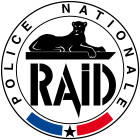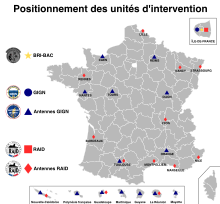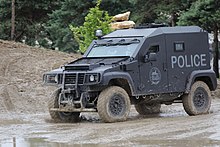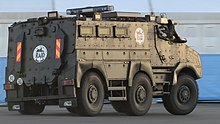RAID (French police unit)
| Search, Assistance, Intervention, Deterrence | |
|---|---|
| Recherche, Assistance, Intervention, Dissuasion (French) | |
 Écusson du RAID | |
| Active | 1985 – present |
| Country | |
| Agency | National Police |
| Type | Police tactical unit |
| Role | Law enforcement Counter-terrorism Hostage rescue Close protection |
| Headquarters | Bièvres, Essonne |
| Motto | "Servir sans faillir" "To serve without failing" |
| Abbreviation | RAID |
| Structure | |
| Operators | Approx. 450[1] |
| Commanders | |
| Current commander | Guillaume Cardy[2] |
| Notable commanders | |
| Notables | |
| Significant operation(s) |
|
Recherche, Assistance, Intervention, Dissuasion ("Search, Assistance, Intervention, Deterrence"), commonly abbreviated RAID (/reɪd/; French: [ʁɛd] ⓘ), is an elite tactical unit of the French National Police. Founded in 1985, it is headquartered in Bièvres, Essonne, approximately 20 kilometres (12 miles) southwest of Paris.[3] RAID is the National Police counterpart of the National Gendarmerie's GIGN. Both units share responsibility for the French territory.[note 1]
Since 2009, RAID and the Paris Search and Intervention Brigade (BRI), a separate National Police unit reporting directly into the Paris Police Prefecture (French: Préfecture de police de Paris),[note 2] have formed a task force called National Police Intervention Force (French: Force d'intervention de la Police nationale) or FIPN. When activated, the task force is headed by the RAID commander. Thirteen regional units of the National Police, previously known as National Police Intervention Groups (GIPNs), have been created or permanently integrated into RAID and re-designated as "RAID branches" (French: antennes RAID) between 2015 and 2019.[note 3]
Missions
[edit]
Among the main missions of RAID are:[4]
- Counter-terrorism in coordination with UCLAT, the co-ordination unit for the fight against terrorism (French: Unité de coordination de la lutte anti-terroriste).
- Hostage recovery situations
- Close protection of VIPs
- Protection of some of the French embassies in war-torn countries (a mission shared with the Gendarmerie's GIGN)
- Site protection during special events
- Resolution of prison riots
- Assistance to other police departments fighting against organized crime
- Surveillance and arrest of high-profile criminals
- Arrest of dangerous deranged persons
- Training and assistance to foreign police forces
- Assessment of new equipment and techniques.
RAID reports to the director general of the National Police (DGPN), himself a direct report of the minister of the interior.
- VIP protection demo in a dangerous zone
-
Firing back at the ambushers.
-
Extracting the VIP from his vehicle.
-
Escorting the VIP away to another vehicle.
History
[edit]Before the creation of RAID, the National Police did not have a national unit comparable to the Gendarmerie's GIGN and relied instead on regional units: BRI in Paris and the GIPNs in the provinces. Minister of the Interior Pierre Joxe was the key decision maker who authorized the creation of the unit.[5][note 4] RAID was founded by then-commissaires Robert Broussard and Ange Mancini in 1985. Broussard, one of the best known Police commissaires at the time, was one of the advisers who pushed the project. Mancini was chosen to be the unit's first commander.[5] RAID's first mission - a hostage situation in a Nantes tribunal, took place soon afterwards in December 1985.[6]
In 1987 RAID arrested the leaders of the terrorist group Action Directe in their Vitry-aux-Loges hideout.[6] In May 1993, RAID solved a delicate hostage situation when a man named Erick Schmitt, calling himself "HB" (for "Human Bomb", in English), and carrying large quantities of explosives, took 21 hostages in a Neuilly-sur-Seine nursery school.[7] The hostage taker was finally shot and the children were recovered safely, together with their teacher and a nurse. In 1996, in Roubaix, the unit neutralized the Gang de Roubaix, a 14-member terrorist group tied to the Armed Islamic Group of Algeria (GIA), suspected of several bank robberies, murders, and a failed attack against the Group of Seven (G7) meeting in Lille. The assault was very violent and resulted in the death of four terrorists. Two RAID operatives were also injured, one by a grenade blast, the other hit by a bullet in a lung.[6] Christophe Caze, the head of the group, escaped the burning building, but was killed at a Belgian checkpoint during a gunfight with Customs agents. Several days later, thanks to an electronic device found on Caze's body, Fateh Kamel, head of a terrorist cell in Montreal, was arrested in Jordan and tried in France.
RAID operators saw action during the 2005 and 2006 riots in France, as well as in a hostage situation in Versailles, where an armed man was shot dead by RAID operators after coming under attack. On 21 and 22 March 2012, RAID was tasked to arrest Mohammed Merah, the main suspect for shooting sprees in Toulouse and Montauban. RAID surrounded the flat where Merah was entrenched. After 30 hours of siege, RAID stormed the flat to apprehend Merah who fought back. After a four-minute shoot out, Merah was shot by a RAID sniper while exiting the building.[8]
On 9 January 2015 RAID, together with BRI, a unit of the Paris Metropolitan Police, ended the hostage situation at the kosher supermarket Hypercacher on the third day of the January 2015 Paris terrorist attacks.[9] On 14 November 2015 RAID, again with the Paris BRI, took part in operations at the Bataclan theatre, where 90 people were killed during a series of bombings, shootings and hostage taking in Paris on 13 – 14 November. On 18 November RAID undertook a follow-up operation in Saint-Denis seeking Abdelhamid Abaaoud, the 'mastermind' of the attacks, who was killed.[10]
RAID also provides close protection for foreign dignitaries traveling in France. During special events, RAID is also in charge of protecting French individuals abroad (For example, the French Delegation during the Olympic Games is under RAID protection during the whole event).
Three RAID officers have been killed in action: two in Ris-Orangis (near Paris) in 1989 and one in Corsica in 1996.[11]
Organisation
[edit]
RAID has a total strength of around 450 men and women, approx. 180 of which are in Bièvres, the rest in the regional branches located in Bordeaux, Guadeloupe, Lille, Lyon, Marseille, Montpellier, Nancy, New Caledonia, Nice, Rennes, Réunion, Strasbourg and Toulouse. The Bièvres (Paris) unit is divided into three main sections with about 60 members each:
- First Section: The first section deals with the usual tasks of special forces: intervention, monitoring, protection.
- Second Section: The second section is the Research and Development unit of the RAID. It studies techniques and collects information. This section is divided into three groups:
- Intelligence Group
- Technical Group
- Weaponry Group
- Third section: The Third section deals with the psychological aspects of the interventions. It is in charge of negotiations and crisis management. It also provides psychological support for the policemen in the unit and in the whole French Police. It is composed of forensic experts, a psychologist and physicians.
The Negotiation group is on permanent alert. It deals with suicides, violent crises, mental disorders, hostage crises and other major troubles, independently from the rest of the RAID. It assesses the dangers of the situation, suggests possible solutions, and helps with the negotiations and the resolution of the crises. If the whole RAID has to intervene, the Negotiations section is used as a reconnaissance unit, and prepares the intervention of the other sections. To join the unit, an officer needs five years duty within the Police Nationale and after passing a thorough test he will serve in the RAID for five years. With a commendation he can expand it further five years. All members must leave the tactical unit after ten years. Candidates must be under forty to apply. Female officers are admitted in almost all positions.
Helicopter support is provided by Sécurité Civile and the National Gendarmerie. Tactical deployment of large groups is handled by GIH (French: Groupe interarmées d'hélicoptères) a joint army/air force special operations flight equipped with SA330 PUMA helicopters based in nearby Villacoublay air base. GIH was established in 2006, initially to support GIGN. Its role has been expanded to also support RAID in 2008.
Coordination between GIGN and RAID is handled by a joint organization called Ucofi (French: Unité de coordination des forces d’intervention). A "leader/follower" protocol has been established for use when both units need to be engaged jointly,[note 5] leadership belonging to the unit operating in its primary area of responsibility.[12]
RAID is also a member of the European ATLAS Network, an informal association consisting of the special police units of the 28 states of the European Union.
RAID Commanders
[edit]- Ange Mancini: 1985-1990
- Louis Bayon: 1990-1996
- Gérard Zerbi: 1996-1999
- Jean-Gustave Paulmier: 1999-2002
- Christian Lambert: 2002-2004
- Jean-Louis Fiamenghi: 2004-2007
- Amaury de Hauteclocque: 2007-2013
- Jean-Michel Fauvergue: 2013-2017
- Jean-Baptiste Dulion: 2017-2023[13]
- Guillaume Cardy : since 2023
Specialties
[edit]- Assault Groups
- Sniper
- Parachutist
- Diver
- Demolition
- Breaching
- Group of Research and Information
- Dog handlers
- Logistics
- Negotiators
Equipment
[edit]Weapons
[edit]
- Benelli M3
- Beretta M3P4
- Colt M4A1
- FN Herstal Five-seveN
- FN Herstal P90[14]
- FN SCAR
- FN Herstal Minimi
- Franchi SPAS-15
- Glock 17 / 17L / 18 / 19 / 26 / 34
- Heckler & Koch G36
- Heckler & Koch HK53
- Heckler & Koch HK69A1
- Heckler & Koch MP5K
- Heckler & Koch PSG1
- Manurhin MR 73
- PGM Précision Hécate II
- PGM Précision Ultima Ratio
- Remington 870
- Rheinmetall MG3
- SIG Sauer SG553
- SIG Sauer MCX
- Saiga-12
- Kel-Tec KSG
- Bastinelli Knives FIXED R.E.D V2 [15]
- Bastinelli Knives Grozo
Vehicles
[edit]

See also
[edit]- Groupe d'Intervention de la Gendarmerie Nationale (GIGN)
- ATLAS Network
- Counter-terrorism
- List of special police units
- National Liberation Front of Corsica
Notes
[edit]- ^ Each of the two French national police forces, the National Police and the National Gendarmerie has primary responsibility for a part of the territory: large cities and urban areas for the National Police, smaller cities and rural areas for the National Gendarmerie.
- ^ The Paris Préfecture de Police (commonly abbreviated PP) is an organization tailor-made to handle the specific requirements of Paris (a large city and the country's capital). It reports directly to the Ministry of the Interior and controls several non-police departments such as the Paris Fire brigade.
- ^ "Arrêté du 16 avril 2018 portant diverses dispositions relatives au recrutement, à la formation, aux missions et à l'organisation des services composant la force d'intervention de la police nationale en outre-mer - Légifrance". www.legifrance.gouv.fr. Retrieved 22 April 2024.
- ^ Later, as defence minister, he was instrumental in creating the French Special operations command (French: Commandement des opérations spéciales or COS) after the Gulf War.
- ^ As was the case following the January 2015 "Charlie Hebdo" assassinations. In fact both units were engaged separately but good coordination was necessary since both actions were almost simultaneaous
References
[edit]- ^ Peeters, Steve-Henry (19 June 2019). "Le RAID officiellement à La Réunion". Réunion La Première (in French). France Télévisions. Retrieved 2 February 2021.
- ^ {{cite web |https://www.legifrance.gouv.fr/jorf/id/JORFTEXT000048530745
- ^ Aleksander Olech, French and Polish fight against terrorism, Poznan 2022, p. 100; https://www.researchgate.net/publication/359135918_French_and_Polish_fight_against_terrorism
- ^ "Le RAID (Recherche, Assistance, Intervention et Dissuasion)". Ministère de l'intérieur (in French). 13 July 2012.
- ^ a b Broussard, Robert (2012). Mémoires du commissaire Broussard (in French). Paris: Nouveau monde éditions. pp. 763–766. ISBN 978-2847366693. See also: Courtois, Jean-Louis (1999). Le RAID: L'unité d'élite de la Police Française (in French). Paris: Pygmalion. pp. 21–27. ISBN 978-2-85704-576-2.
- ^ a b c Tanguy, Jean-Marc (2015). Le RAID - Trente Ans d'Intervention [RAID - 30 years of intervention] (in French). Paris: Editions Pierre de Taillac. ISBN 978-2-36445-064-6.
- ^ "Erick Schmitt". Affaires-criminelles.com (in French). Archived from the original on 4 March 2008.
- ^ "WRAPUP 7-Gunman dies in hail of bullets as French siege ends". Reuters. 22 March 2012. Retrieved 22 November 2015.
- ^ Zara, Christopher (7 January 2015). "Charlie Hebdo Attack: Anti-Terror Raid In Reims, France". International Business Times. Retrieved 22 November 2015.
- ^ Breeden, Aurelien & de Freytas-Tamura, Kimiko (19 November 2015). "Chief Suspect in Paris Attacks Died in Raid, France Says". The New York Times. Retrieved 19 November 2015.
- ^ de Hauteclocque, Amaury (2009). Histoire(s) du RAID (in French). Paris: Editions Jacob-Duvernet. ISBN 978-2-84724-235-5.
- ^ "Colonel Bonneau interview". L'Essor de la Gendarmerie Nationale (in French) (478). February 2015.
- ^ "Le nouveau patron du Raid, Jean-Baptiste Dulion, prend ses fonctions" [The new boss of the Raid, Jean-Baptiste Dulion, takes office]. Europe 1 (in French). 20 March 2017.
- ^ Direction générale de la police nationale (2005). Le RAID: Unité d'élite de la police nationale (in French). Chaumont: Crépin-Leblond. ISBN 978-2-7030-0264-2.
- ^ "Fixed R.E.D V2 Industrial Knives". Bastinelli Knives.com. Retrieved 2 November 2016.
Bibliography
[edit]The following books and articles are in French.
Books
[edit]- Tanguy, Jean-Marc (2015). Le RAID - 30 ans d'intervention [RAID - 30 years of intervention]. Paris: Editions Pierre de Taillac.
- Broussard, Robert (2012). Mémoires du commissaire Broussard [Commissaire Broussard remembers]. Paris: Nouveau Monde Editions.
- de Hauteclocque, Amaury (2009). Histoire(s) du Raid [RAID stories]. Jacob Duvernet Editions.
- Courtois, Jean-Louis (2000). Le RAID, l'ultime recours [RAID, the last resort]. Crépin-Leblond.
- Le RAID, Unité d'élite de la Police Nationale [The RAID, an elite unit of the National Police]. Crépin-Leblond. 2005. (DVD included)
- Courtois, Jean-Louis (1999). Le RAID, l'unité d'élite de la Police Française [RAID, an elite unit of the French police]. Pygmalion-Gérard Watelet.
- About, Jean-Pierre (2005). HB, 46 heures qui ont bouleversé la France [HB, 46 hours that shook France]. Editions Tarcher.
- Boulanger, Daniel (2007). Le jour où j'ai tué HB [The day I killed HB]. Hachette.
Magazines
[edit]- "Le RAID en action" [The RAID in action]. Special Edition RAIDS. No. 19. 2005.
- "RAID, 20 ans d'action" [RAID, 20 years of action]. Commando. No. 20. January–December 2005.
- "La sélection du RAID" [The selection process for RAID]. Police Pro. No. 8. March–April 2008.
- "Le RAID, 20 ans d'opérations" [RAID, 20 years of operations]. RAIDS. No. 233. October 2005.
- "RAID: refuser la fatalité" [RAID: reject the inevitability]. Police Frequency. No. 2. October 1987.
- "La police face à l'exception: flics de choc" [The police deal with the exception of shock cops]. Civic. No. 53. August–September 1995.
External links
[edit]- "RAID". Ministry of the Interior (in French).
- "RAID (Unofficial Site)" (in French). Archived from the original on 9 January 2016.
- "French Police Nationale RAID". Specwarnet.



